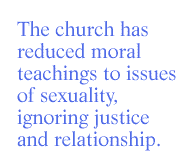
Question III
In The Soul of Sex, Thomas Moore says "religious institutions remain close to pornography, sometimes in their art . . . because ultimately both are concerned with life's deepest meaning and mystery." Do you see any connection between Catholicism and porn? Did Catholic artists ever purposely infuse their art and iconography with suggestions of sexuality in order to help convey the power of spiritual ecstasy to the masses (consider such Christian-themed works as the illustrated "O" in Bede's commentary on the Song of Songs, Donatello's David, Caravaggio's Doubting Thomas, and Bernini's The Ecstasy of St. Theresa)? And, if so, how should that affect the way we interpret contemporary renditions of Christianity such as Andres Serrano's photograph Heaven and Hell, Martin Scorsese's film The Last Temptation of Christ, Madonna's video "Like a Prayer," and Terrence McNally's play Corpus Christi (all of which many religious fundamentalists have condemned as pornographic and blasphemous)?

